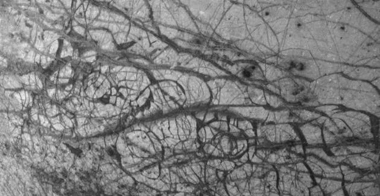As one of the major moons of
Jupiter,
Europa is
thought to be the only other planet or moon in our
Solar System to contain liquid water. There are
several key pieces of evidence to support this:
- Presence of a very thin atmosphere
containing Oxygen - detected by the
Hubble Space Telescope
- Cracks on the surface of
Europa caused by a
warmer liquid underneath (Europa also has a
lower density than
Earth, so material underneath
the surface is not solid)
- Lack of
meteorite impact craters indicates
active geology
- Islands of thicker ice resemble that of the
Earth's polar caps

The image above shows the "cracks" that provide
the best proof of an under the surface activity that
can only come from liquid.
This image below shows a close-up of one
particular group of "cracks."

This shows that some of the liquid underneath
broke through the surface (through some type of
volcanic action) only to be frozen into these
elevated lines.
A common question at this point will be:
Europa
is far from the
Sun, and the surface is completely
frozen, so how can liquid water exist underneath?
There are two schools of thought:
- The
Galileo Space Probe detected a magnetic
field from
Europa, this is more likely due to
liquid having a bit of salt, and the core of
Europa is still warm enough the magnetism is the
result of the dynamo effect
- The intense gravity from
Jupiter causes
"tidal flexing" which prevents all liquid accept
the surface to freeze
Either way, the evidence for an under surface
ocean on
Europa is pretty strong.
But what of life?
Until we send another probe to
Europa for a more
detailed analysis (confirm the magnetic field,
spectral analysis and so forth), we can only
speculate. However, our discovery on
Earth of a new
type of life called "extremophiles" has raised hope
that life could exist on
Europa - albeit a more
primitive bacterial type.
One such example of an extremophile is the Black
Smoker:

These microbes live at the bottom of
the ocean near volcanic vents. What is even more
remarkable is that tube worms have been found near
these vents. They have special bacteria that
converts the hydrogen-sulfide released from these
vents into energy. These worms also supply food to a
vast, newly discovered ecosystem totally independent
from the light and warmth of the
Sun.
Off the coast of Mexico, almost one
mile down, scientists discovered a lake within the
ocean. Comprised of mostly thick brine, this lake
produces methane that feeds mussels that outline the
lake. The mussels also produce hydrogen-sulfide
byproducts that nearby tube worms consume - again
all without the light or warmth from the
Sun.
The presence of these extremophiles
on
Earth has given hope for the search for life in
our own
Solar System - and perhaps the
Universe.
Back to Top |

